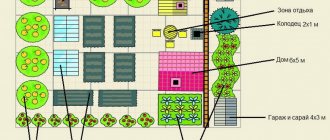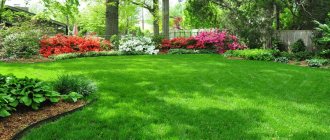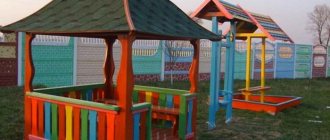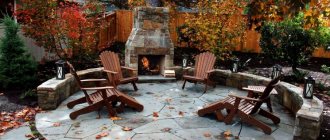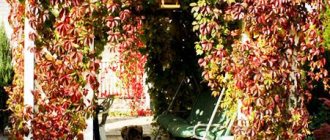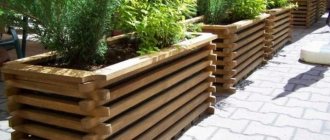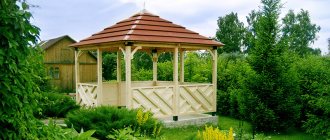What is a discount?
The very meaning of this word translated from German means “narrow flowerbed.” Hence the idea that a ridge is a version of a flower garden or flower bed in shape, resembling an elongated rectangle. It is planted along various structures, paths or hedges.
Today on the Internet you can find many photographs with design options for discounts.
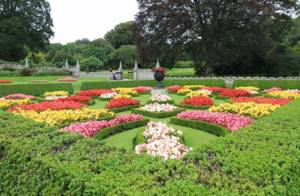
The main thing is that the plants combine organically with each other. The range of plantings can be very diverse: flowers, grass, shrubs, dwarf trees, coniferous species.
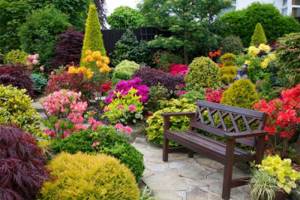
Secrets of discounts
“Bed” is how the name of this composition is translated from German, which is characterized by a rectangular elongated shape, limited to 2 meters in width and about 15 meters in length.
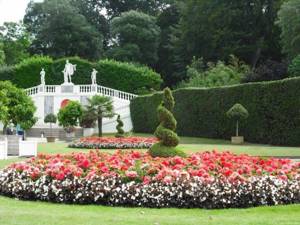
Typically, such flower beds are placed along something: buildings, paths, front gardens, or they zone an area as a kind of dividers and boundaries.
There are several advantages of rabatka among other types of flower beds:
- Easy access to plants;
- Versatility, allowing it to fit into any space;
- Clarity of lines and geometry of color pattern;
- Symmetrical and strict form.
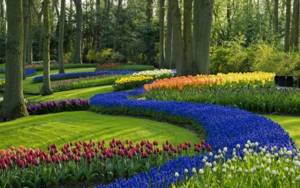
Standard discount rates
If you decide to decorate your plot with such an unusual flower garden, then the question arises, how exactly to make a ridge.
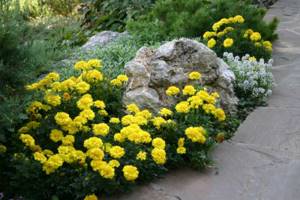
This flower planting has certain standards prescribed by GOST 28329-89. According to these regulations, the length must exceed the width by three or more times. For example, if the width of the flower bed is 40 centimeters, then its length should be at least 120 centimeters.
If you decide to make a flower bed with your own hands, then you should decide which type of flower garden is most suitable for your territory.
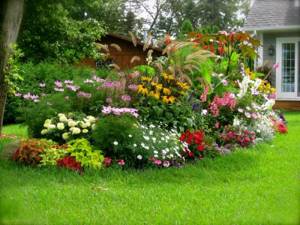
One-sided design option
This type of ridge will be visible only from one side. When creating it, you should adhere to the basic rule: planting of plants follows an increasing pattern.
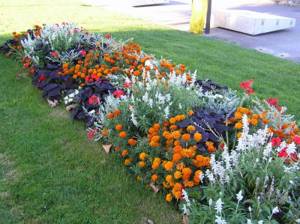
Low plantings are placed in the foreground, and tall crops, perhaps even low-growing or coniferous trees, are placed on the distant side.
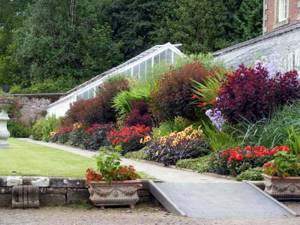
Double-sided plantings
This type of discount is visible from all sides. It is always located away from buildings and fences. In this regard, it is appropriate to place such a ridge along the paths or in the middle of the personal plot.
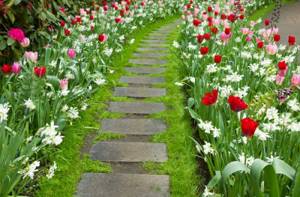
The main rule for planting is simple: there are low-growing crops at the edges, and taller crops in the middle.
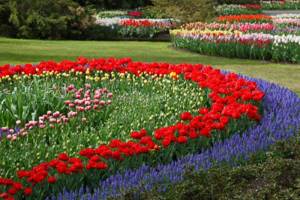
If the width of such a flower bed is large enough, then it is recommended to make a low embankment so that the water drains away and does not stagnate.
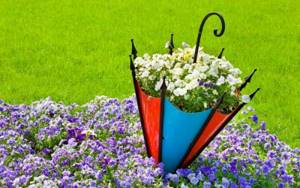
Step-by-step arrangement of the ridge
So, you have carefully planned everything, selected the right plants and location. You can start working!
- The tools you will need are a shovel, a rake, and a watering can. We also stock up on fertile soil (you can collect it in the forest and mix it with fertilizer) and plants for planting, pegs, rope and bricks with boards (they will be used for the border).
- Let's start drawing again, but this time on the ground. Pegs with a long rope are used to mark boundaries.
- Using a shovel, remove the top layer of soil. You shouldn’t dive to great depths – 15 cm will be quite enough. The edges of the groove are lined with curb material.
- The prepared site is filled with fertile soil. Don't try to make the surface perfectly flat. In the center of such a flower garden, water will begin to stagnate after rains. So you can pour several “piles” in the middle, above the main layer.
- Flowers are planted according to the diagram that was drawn on a piece of paper. It may be tempting to plant the plants quite close to each other - after all, they are still so small. Don't give in to temptation. Over time, the empty space will quickly fill with leaves and flowers, and too dense plantings will not allow flowers to develop normally.
- After planting, water the sprouts and leave them for a week. They need time to recover from “stress.”
Symmetrical flower garden
This is one of the varieties of double-sided rabatka. It involves planting plantings in the form of a regular rectangle. This implies that the width remains constant throughout the entire flowerbed.
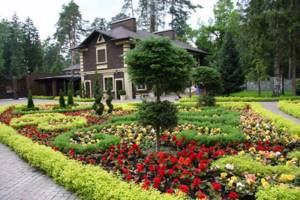
When creating a symmetrical ridge, it is recommended to plant annual plants with a long flowering period. They are arranged in the form of clear shapes, such as stripes, squares, diamonds.

We create a ridge on the site
A short summary. You and I found out what types of flower beds exist, what they are, what principles to follow when forming a flower garden. What to do next?
And we start by remembering our school drawing lessons. We take a piece of paper in our hands and draw a diagram of the arrangement of flowers. It is important to decide in advance where and what flowers you would like to plant. This will help achieve the desired effect.
Plants are arranged in the format of geometric shapes: circles, stripes, squares. The dimensions directly depend on the area of the land. First we distribute the “soloists”, as shown in the diagram, move on to the background and support, and finish with the undersized ones for effective filling.
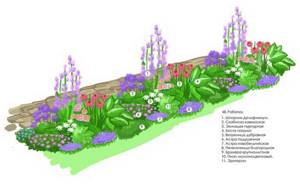
Discount scheme
It is possible that you will wonder: which plants are best to use, annuals or perennials? A flower garden made from annuals looks amazing, it seems light and airy. These perennials tend to grow, while annual representatives of the flora maintain clear forms throughout the season.
Don't want to deal with annuals every year? In this case, your choice will be a perennial plant.
Asymmetrical type of plantings
Another type of double-sided ridge can be called an asymmetrical version of landscaping. It is one of the most interesting, because crops are planted in any form.
The choice of flowers and shrubs is unlimited. There are no rules for placing tiers, clear figures and bends. The only thing is that the ratio of the length and width of the flower bed is maintained.
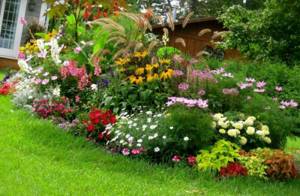
Such a discount will look great along walls and fences.
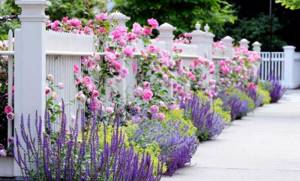
Types and options of discounts
The decorative element can be made in various modifications. Main types:
- One-sided. The name indicates the specific placement of plants. The background is slightly higher, and low or ground cover plants are planted in the foreground.
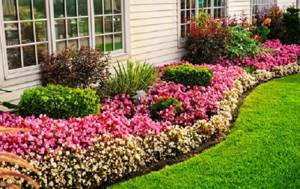
- Double-sided. This placement requires highlighting the central row, consisting of the most noticeable plants. On both sides there are lines of short representatives. In this case, any asymmetry is allowed; parallelism may not be observed.
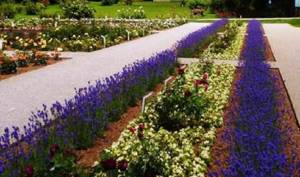
Each type can be varied to suit your taste, consistent with the overall design of the site. Discounts can also be divided into:
- narrow and wide;
- symmetrical and asymmetrical;
- by type of drawing;
- by the number of plants.
By type of drawing there are:
- floral;
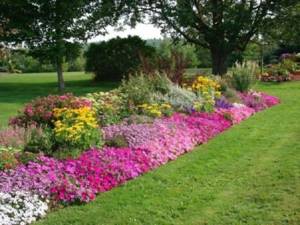
- ornamental.
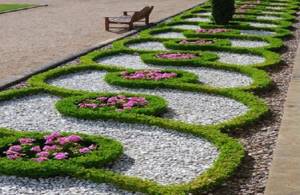
But the number of plants suggests many more design options for ridges:
- Annuals, consisting only of annual crops.
- Perennial of perennials.
- Single-component, in which one type of plant or one color is used.
- Multicomponent, containing several plant varieties.
- Combined with various crops.
According to color scheme, flower beds are divided into:
- monochrome;
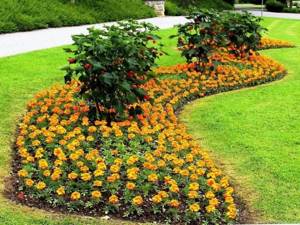
- two-color;
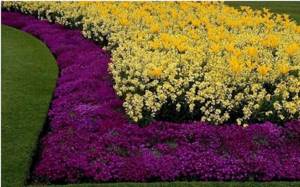
- multicolor;
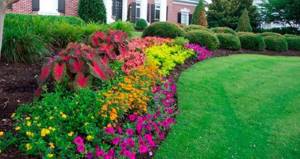
- monochrome;

- contrasting.
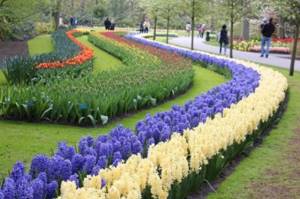
According to the planting method, single-tier, two-tier, multi-tier.
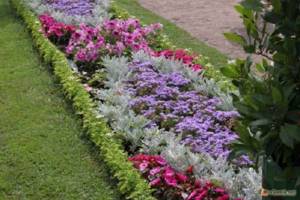
One-sided discounts
This type is characterized by the fact that the approach to the garden bed is possible only from one side. It is recommended to place one-sided beds as close as possible to a wall, path or fence. At the same time, you need to take into account the height of the plants. The background is for those who are taller, the foreground is for the little ones. It is important to coordinate the shade of the colors with the coating of the fence or facade. At the same time, plants of light colors go better with a dark fence, and bright and saturated ones with a color scheme of cool shades. An example of a one-sided extension near the wall of a house:
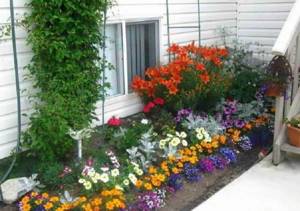
A one-sided flower bed also requires careful planning of the planting pattern. There should be no voids or gaps among the plants. A cascade planting looks good when the front row is formed from low flowers, the second from medium ones, and the last from high ones.
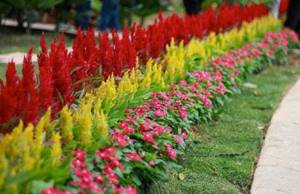
A simultaneous combination of perennial and annual crops would be optimal. Annuals can be changed annually, changing the appearance and colors of the flower bed. If you correctly take into account the timing of flowering at the time of drawing up the garden plan, then a one-sided bed will please the eye all season.
Double sided discount
This type of bed has access from 4 sides. For double-sided flower beds, it is better to use perennials. Flowerbeds are divided into:
- single-tier, in which the height of all elements is the same;

- two-tiered with tall plants in the middle and framed by low-growing ones.
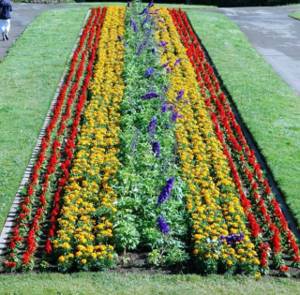
It is more advisable to place a perennial garden bed in a sunny place and in the center of the site, preferably away from houses and buildings. Thus, the composition will be clearly visible from all sides. An excellent option is a bed in the form of a dividing strip on a wide garden path or a flower bed with a mound in the middle.
Important! The mound is made only on wide flower strips.
Symmetrical discounts
The peculiarity of a symmetrical flower bed is its rectangular shape.
When laying out the beds, maintain the same length and width along their entire length. Most often this type refers to double-sided flower beds. The symmetrical arrangement of plants requires strict adherence to tiers. It is not recommended to alternate flowers of different heights and sizes in one row.
Asymmetric discounts
Among gardeners it is considered the most “natural” or “natural” species. It combines straight sections with winding ones. Such a flowerbed can completely follow the lines of the object being surrounded, for example, a sculpture, or partially. In this case, you do not need to follow the rules of tiers and rhythm. Cultures can be arranged randomly at your discretion. But the ratio of length and width cannot be violated.

Intermittent discounts
They are long in length. This type allows you to divide the ridge into sectors or areas separated by perennials.
You can use tall plants or flower beds of other shapes as a dividing element. The interruption points on the ridge are selected randomly and placed at a distance of 5-15 m.
Rules for choosing flowers for discounts
This type of flower garden is easy to decorate. To do this, you can take only a few types of plants. The most unpretentious varieties with different flowering times are selected.

Here the number of flowers does not play an important role; selection can be carried out according to varietal characteristics. A varied color palette will help you create an interesting pattern and avoid monochromatic plantings.
The selection of plants is carried out taking into account the compositional solution. All plantings differ in their varietal characteristics.
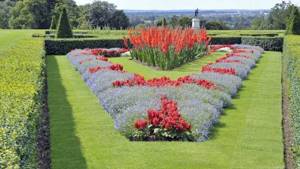
Choice of colors
When developing a flower garden design, you need to consider the following points:
- The flower garden must be in harmony with the style of the yard in terms of color.
- In order for the flowerbed to look impressive for as long as possible, you need to choose plants with different flowering periods.
- When designing a ridge, you need to remember the amount of vegetation - there should not be too many flowers, but gaps are also undesirable.
- When choosing plants to fill a flower bed, you must remember that they must match each other in color.
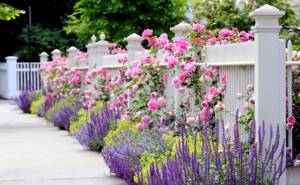
When deciding on a color scheme, you need to remember the harmony of combinations of different shades.
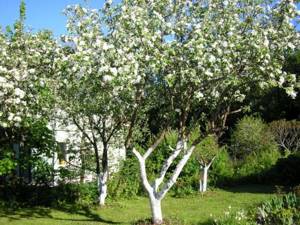
Deciduous trees in landscape design: purpose and application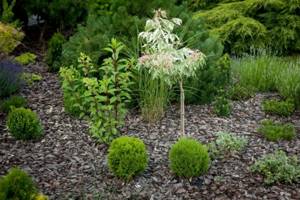
Planting and caring for thuja occidentalis - detailed instructions with tips for properly growing thuja (photos and videos)
- Do-it-yourself vertical flowerbed - learn how to make a beautiful and original flowerbed yourself (photos and videos)
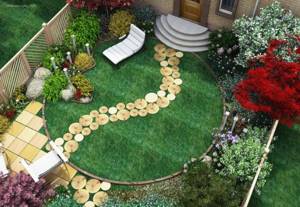
For a monochrome discount, you can use several tones of the same color. For a contrasting flower bed, it is preferable to focus on two main colors and diversify them with background plants.
The most popular flowers are those made from low perennial flowers. They are usually placed along paths. Tall flower beds are placed near fences and walls of buildings.
tall plants
For the garden, the most unpretentious varieties are chosen from tall perennials: peonies, ferns, chrysanthemums.
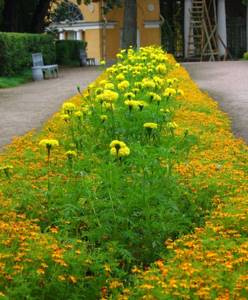
Some of the tall representatives of the fauna grow by the root method. In this case, restrictive devices are used. And this process will require special attention.
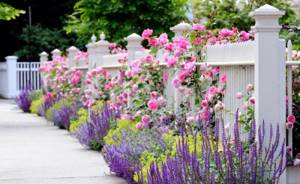
Representatives of this group include: lupine, echinacea, delphinium, aster or bellflower.
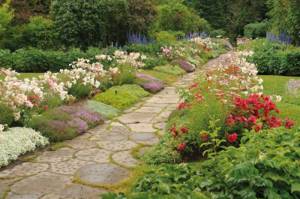
Medium and low-growing perennials
If the design of the garden requires such a group of plants, then you can choose unpretentious varieties. These include cloves, chamomile, dicentra, fescue, etc. When controlling the area of growth, you can purchase irises, hostas and daisies.
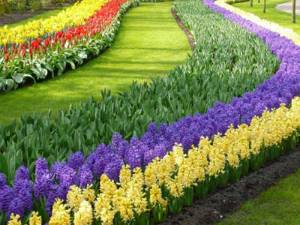
Residents of warmer regions can delight with their beauty lavender, maned barley and evening primrose.
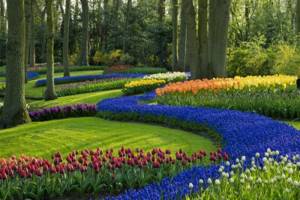
Drawing
Depending on the purpose of creation, location and general design idea, a plant arrangement pattern is selected. This can be a clear symmetrical fit, a graphic design, or a loose fit.
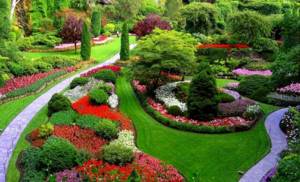
When choosing a laconic form, symmetry is observed in everything, the width of each row and its location relative to the edges and center are taken into account. If the design of a flower garden involves a freer option, reminiscent of the natural growth of plants, then it is important to think through the general concept.
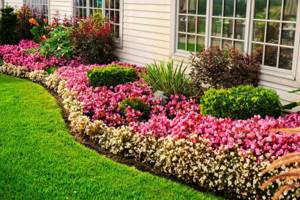
Annuals of medium and low height
Despite the need for annual planting, these representatives of the fauna will delight you with a long period of budding.
The most popular in this group are zinnias, ornamental cabbage, kochia, viola and lobelia. The longest flowering period is for marigolds, calendula and petunias.
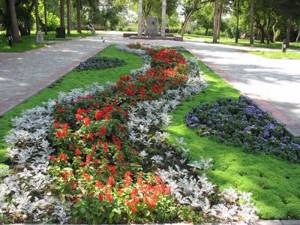
There is a ridge option where annual and perennial plants are combined. In this case, you will not have to renew the plantings throughout the entire area of the flower garden every year.
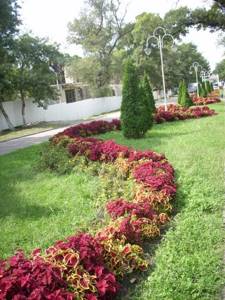
Choosing plants
The aesthetic properties of the flower bed will depend on what plants you choose to decorate it with. It is very important to provide for their duration and seasonality of flowering, so that some of the plants do not lose their appearance faster than others.
Tip: choose perennial planting patterns along the path - and you won’t have to think every year about which plants to choose for your site.
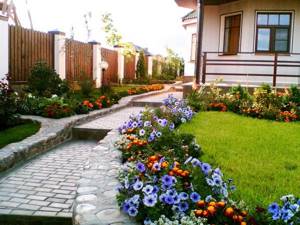
A ridge of perennials along the path, photo
Colorful flowers are obtained using daffodils, tulips, and snowdrops. After they stop blooming, you can use other ready-made designs for flower beds made from annuals: marigolds, petunias, impomiums and other colorful plants.
When decorating ridges along paths with subtropical flowers, more effort will be required to care for the vegetation. Exotic flowers like Godetia and Chinese carnations can be replaced with asters, calendulas, and bindweeds.
Please note that the flowers for the discount must be in harmony with each other in color scheme. If you decide to focus attention on bright plantings like salvia or ageratum, plant plants around them that are not so saturated in color, for example, daisies, roses or peonies.
If you do not plan to create complex accent patterns on the site and are counting on creating neat flower beds using only one type of plant, choose daisies, lilies, phlox, dahlias, asters, chrysanthemums and other flowers that are available everywhere.
Marigolds, sedums, lobelias, hosts and other types of flowering plants are more suitable for patterns and designs.
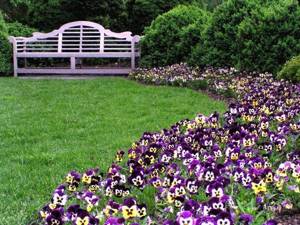
Flowers from perennials, photo
Tip: if you are decorating the garden with flowers with attractive buds that do not have large beautiful leaves, use additional greenery to decorate this area.
For landscaping, you can choose kochia, trimmed into a ball, or ornamental bushes with long flowering. Make sure to promptly remove faded plants from the area. By the way, you can use spices and vegetables together with annual plantings for decoration. For example, physalis, mint, oregano, hot pepper, chard, and thyme are suitable for you.
What color scheme is considered the best for garden plots in suburban and summer cottages? You can use flowers of only one shade: white, blue, pink, light blue, orange, purple, red, or combine several colors that do not contradict each other.
You can alternate two or three colors, create a rainbow decor, create bright accents in the center or on the sides, emphasize the symmetry or, conversely, the asymmetry of the patterns.
If you want to make a high ridge, you can plant dwarf spruce trees, marigolds, asters, and junipers. Tulips, chrysanthemums, daffodils, yarrow, and crocuses are suitable for medium-length flowers.
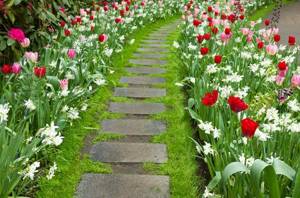
Flowers for discounts: photos and names
When choosing flowering schemes for continuous flowering or with plants that will later bloom, immediately take into account the correct placement of vegetation. In addition to height, consider the distance between each flower or grass. For each square you can plant no more than nine low-growing plants, five of medium height and four of high height. Moreover, when planting, pay attention to the presence of gaps between the upper parts of plants and flowers.
If you design a discount in the form of a zigzag, they will be present. In interruption areas, you can place flower beds of different shapes and parameters, as well as large plants like roses or dahlias.
By the way, experts in the field of landscape design recommend cutting off the ridge every five to fifteen meters. Therefore, for example, a ten-meter ridge should be divided once. If it is difficult for you to think over its appearance, taking into account the characteristics of your site, it is better to invite specialists who will not only give advice on the form and parameters, but also suggest which landscaping will be most successful.
Combinations of annual and perennial plants are considered the best, since such plants will always look bright and attract attention. And if you choose plant varieties that still look aesthetically pleasing after flowering, you can enjoy the beauty of the natural landscape at any time.
We suggest you study photos and names of beautiful flowers for the garden that bloom all summer, if you want to delight your household with original flowering flower beds for a long time before the autumn frosts.
Read about which fast-growing trees and shrubs are recommended to be planted for hedges here.
You can see photos with examples of designing a flower bed with roses in the article at:
Bulbous flowers
Often the ridge along the paths is decorated with bulbous plants. Among them: daffodils, snowdrops, crocuses, tulips. They are distinguished by early flowering.
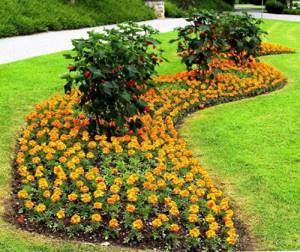
After which their above-ground part dies off, and the aesthetics of the entire planting is lost. To avoid this, they are combined with summer flowering varieties.
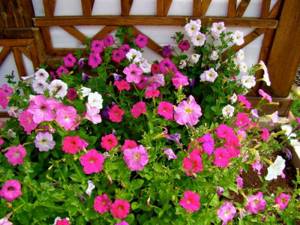
However, even among the bulbous varieties you can find varieties that will please the eye even in the first half of summer. These are lilies, decorative garlic and gladioli.
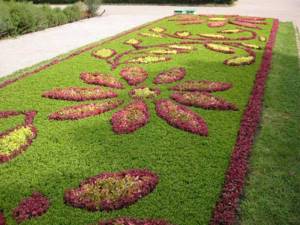
Shrubs and conifers
These representatives of the fauna do not cause any special care, and can grow for decades.
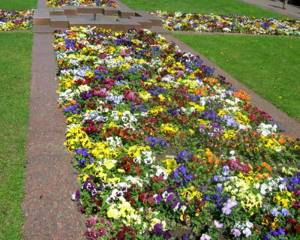
The most popular among them is spirea. There are many types of it, which differ in height and color of foliage. Adapted to haircut. Among conifers, preference is given to low-growing pines and dwarf spruces.
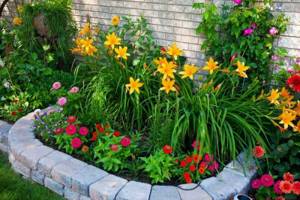
Design of a discount
If you decide to create such an unusual flower garden, then be especially careful when choosing plants.
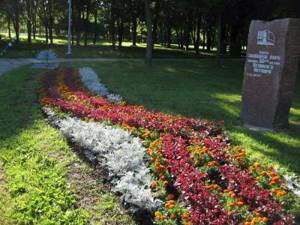
Study in detail their varietal characteristics, namely, height, degree of growth, splendor and flowering period. And based on these features, draw a diagram of the ridge, on which indicate the planting locations and sizes of all plants.
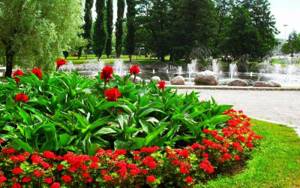
Decorative flowering plants
Most gardeners choose plants for gardening among annuals and perennials. What you need to pay attention to when choosing them:
1. Do not plant the ridge only with perennial plants. Otherwise, voids will form in the flower garden over time, because... some species begin to fade immediately after flowering. Therefore, perennials must be diluted with annual plants that bloom almost all summer. Or give preference to late-blooming perennials, which bloom longer than others.
2. To ensure that the flowering plant pleases you from early spring to late autumn, also take into account the timing and duration of flowering. It’s good when the flowers bloom on it at different times.
Plants most often used in flower gardens: snapdragons, marigolds, poppies, mallow, bellflower, aster, nasturtium, petunia, marigolds, pansies, zinnias, border dahlias, cosmos, gillyflower, lobelia, lilies, rudbeckia, godetia, coreopsis and others .
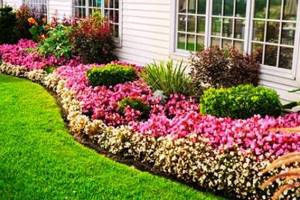
Golden rules when creating
The flower arrangement will turn out original and stylish if you follow simple rules when creating it.
- Consider the size of the future plant in advance. As you grow, try to achieve maximum density so that no patches of soil are visible.
- Avoid variegated plantings. The selected varieties should be harmoniously combined in color. Contrasting options are allowed, but no more than 4 pieces.
- Strict adherence to planting density.
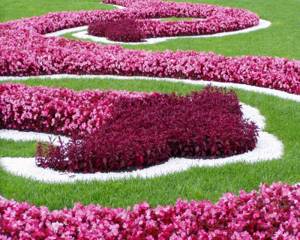
According to standard standards, 9 miniature, 4 tall and 5 medium-sized varieties can be planted per 1 sq.m. But it is not permissible to plant more than 18 plants at the same time.
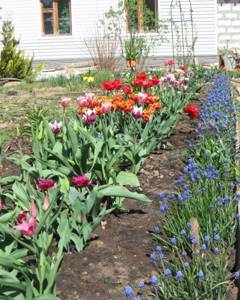
Of course, a ridge is a living decoration for a personal plot. Anyone can create it if they want, they just need to put in some effort. This flower garden will delight you all summer.
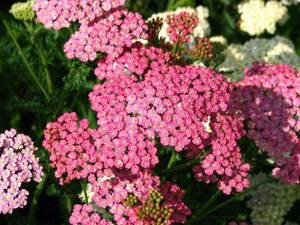
These plantings are very popular when decorating landscape designs. They can be seen in city parks and squares, squares and near residential buildings.
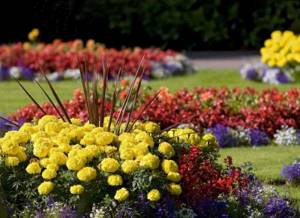
Such stylish flower beds are also very popular among lovers of country life. Rabatki in the country are used both for zoning the territory and for decorating paths and recreation areas.
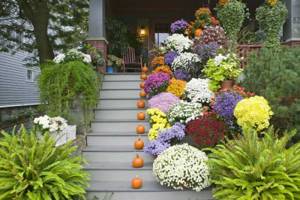
Let's get to know the discount girl
In essence, we are talking about a flower garden, but with its own characteristics. It differs from other flower beds in shape, as it is a long bed. It is rectangular and comes from the Middle Ages. By the way, in those days flower beds decorated courtyards and served as a pharmacist’s garden bed.
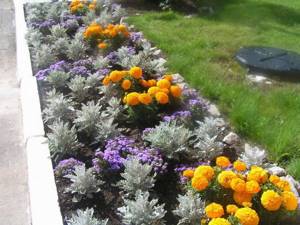
Rabatka - long bed
To make it clearer, let's talk about proportions. The ideal option is 1:3, although in reality this norm is rarely maintained. What are these numbers, you ask. We are talking about rows of plants. A small discount consists of 3 rows, large ones - about five. If you strictly follow the design idea, a seemingly small floral ribbon can unfold up to 10 meters.
Work at the dacha is always solemn and beautiful. All elements are repeated in the form of groups or stripes. By the way, this is what distinguishes them from mixborders.
So, let's summarize
- We are talking about a long flower bed in the form of a strip.
- Its width varies from 0.5 to 3 meters.
- As a rule, the flowerbed is placed near the path.
- Can become a worthy decoration for an unsightly foundation.
